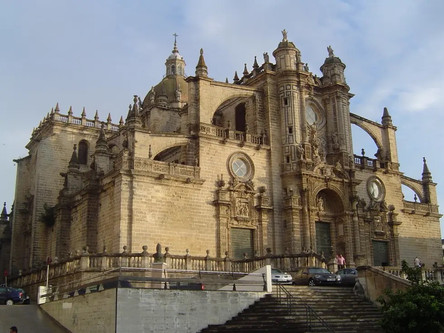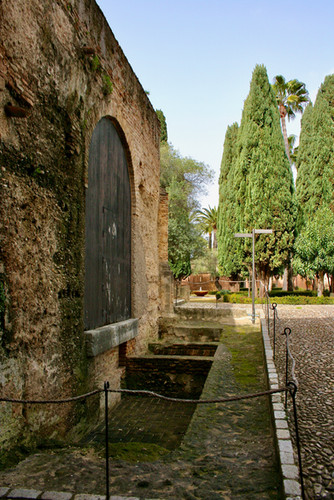Jerez de la Frontera
- Fiona
- Mar 30, 2021
- 5 min read
Jerez de la Frontera is a municipality in the province of Cadiz and one of Cadiz City’s closest neighbours, and it was to Jerez that we went on our first excursion beyond the city walls when the covid-busting perimeter restriction was eased earlier this month.
Travelling by train we alighted at the fabulous Jerez de la Frontera train station which is worth a mention for its striking design that, like the Plaza de Espana in Seville looks historic but was actually constructed between 1928 and 1930 for travellers who would visit the Ibero-American Exposition in Seville. These similarities with the Plaza de Espana are no coincidence as it seems that the Jerez train station and the Plaza de Espana were designed by the same architect, Anibal Gonzalez, and he used similar Mudejar elements such as brick and beautiful ceramic tiles on the facade (see earlier post on the Plaza de Espana in Seville here and here)
Jerez - a quintessential Spanish town...
In non-covid times, Jerez it is a microcosm of Andalusian culture—from flamenco dancing to dancing horses. In fact there is an actual Royal Andalusian School of Equestrian Art in Jerez that is devoted to the conservation of the ancestry of the Andalusian horse and the maintenance of the classical traditions of Spanish baroque horsemanship and the school also hosts an equestrian ballet to entertain tourists!
Even though performances of flamenco and dancing horses aren’t happening at the moment, we still managed to find many things to see and do in Jerez including checking out the architecture in the old town and sampling the tipple for which Jerez is also famous - sherry!
Wisely, we decided to explore Jerez before we began our sherry appreciation, and so we spent the morning strolling along the narrow cobbled streets of Jerez’s old town stopping first at the elegantly dilapidated 15th-century church on Plaza de la Ascuncion - where while there is no church of the Asunción in the Plaza it does have one of the oldest churches in town, the church of Saint Dionysius. which was built in a Gothic-Mudéjar style in the late 15th century. And there is also a rather impressive sculpture in the centre of the plaza that does represent the Asuncion.
A coffee break - in the stately Plaza del Arenal - a square that is lined with bars and cafés with outside terraces and that has, in its centre, a statue and fountain of Miguel Primo de Rivera, Jerez-born Prime Minister of Spain from1923 to1930. We sipped our coffee, watching the locals going about their business, and imagined what it might have been like in the days of the Moors when the plaza was the town meeting place and later in the 16th century when it was the venue for tournaments, duels and equestrian and bullfighting shows.
Next we wandered purposefully toward the Jerez Cathedral, a building that had a rather neglected exterior in dire need of weeding! The current church was built on the site of an old mosque between 1695 and 1778 and only officially became a Cathedral in 1980. In fact it was during the time of Pope John Paul II that it became a Cathedral and the people were so chuffed that they had a rather striking statue of the Pope made and placed right next to this impressive piece of architecture. The Cathedral itself is a mix of architectural styles including a Renaissance dome capped by Andalusian Azulejos - tiles, Gothic flying buttresses supporting a Baroque facade and a separate bell tower that is reminiscent of a minaret. It was closed and so sadly we didn’t get to see inside.
Our last stop before lunch was at the Jerez Alcazar, which was just a short walk from the Cathedral. We approached this rather impressive Moorish residence and defence complex by walking up a gentle slope with an orange tree grove on our right and tall stone crenelated walls on the left. The path guided us to the entrance that was in the shadow of a large tower.
The Jerez Alcazar dates from the 11th century and is enclosed within a substantial stone wall that has a 14th-century octagonal watch tower in one corner. Within the walls there is a collection of buildings which in past centuries served as the base for political and military power for Moor and then Christian rulers. What we saw was an interesting mishmash of gardens, buildings and architectural styles that reflected the different rulers of Jerez.
We emerged from the entrance hall (which is actually part of the Baroque Villavicencio Palace of built in1664 on the site of an Arab palace) and immediately entered the Patio of Arms (Patio de Armas) - an expanse of paving where Moor leaders and then Christian governors had watched their armies drill.
We crossed the Plaza to walk along a cypress tree lined path to view the restored bathhouse (hammam). The spaces in the bathhouse started at an entrance area for undressing, then led to a cold room and then a warm room both of which had interesting vaulted ceilings that had star-shaped cutouts to allow in light; and finally to a hot room that had the heating system on display.
After the bathhouse we continued walking through the gardens and then up some steps to the Alcazar ramparts to take in views of the Alcazar's gardens and buildings from up high. We then continued climbing - this time up some very steep and uneven internal stairs of the octagonal watchtower for extensive views of the city and surrounding countryside.
Making our way back to the Plaza de Armas and the exit we stopped to explore the mezquita (mosque) the only survivor of 18 mosques which once existed in Moorish Jerez. Apparently it survived the Christian takeover in the middle of the 13th century because it was concealed within the walls of the Alcazar and the Christians converted it to a chapel.
Over the following three hundred years, the walls of the Alcazar gradually deteriorated and at the end of the 16th century, the city council abandoned it. After that, the complex was in the hands of a number of private owners who undertook various 'developments' including the Baroque Villavicencio Palace noted above until 1996 when, back under the control of the city council, a major restoration project commenced.
The mosque is one area of the Alcazar where the restoration is complete and we were able to view its minaret, a patio/courtyard with a central fountain for cleansing and a prayer hall with a mihrab - a niche oriented towards Mecca. We had the place pretty much to ourselves and so we wandered leisurely though the inner courtyards, the prayer hall, the bricked arched doorways and out into two beautiful honey-coloured brick exterior courtyards, that had several heavily laden orange trees and where we paused to enjoy the tranquility while basking in the warm sunshine.
And then it was lunchtime...
Coming soon





























































































































Great to have you back blogging, Fiona, must be lovely to be able to travel around again. Wonderful photos and text, almost making me reconsider Nelson NZ as a permanent home...
Also, really good to have the captions back on the photos again, well done!
xx